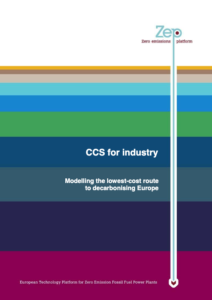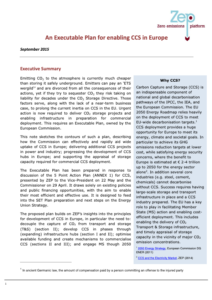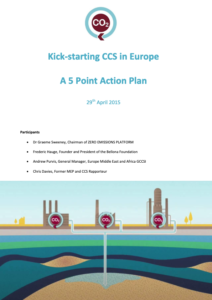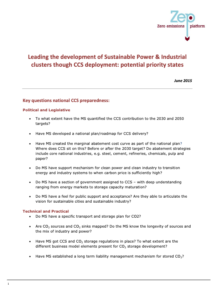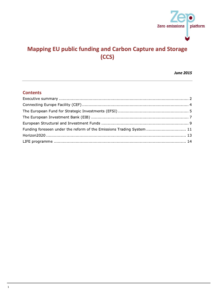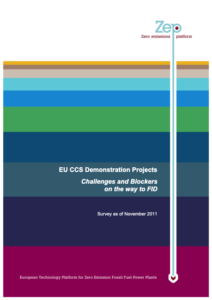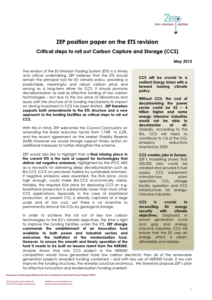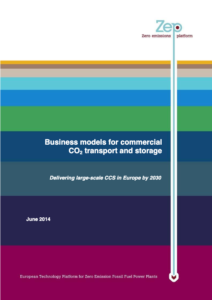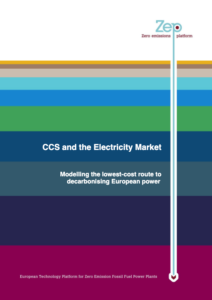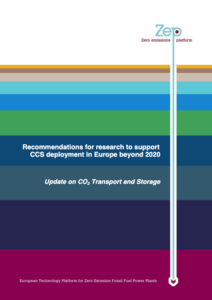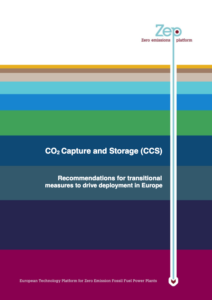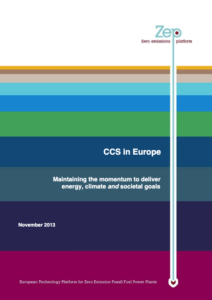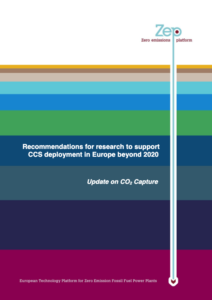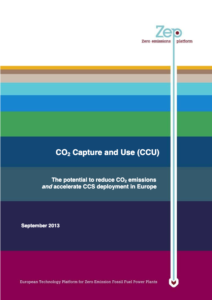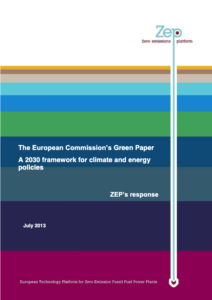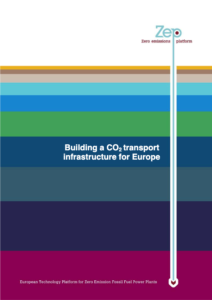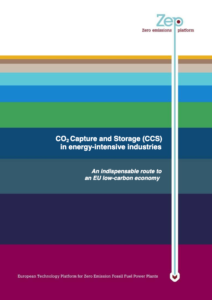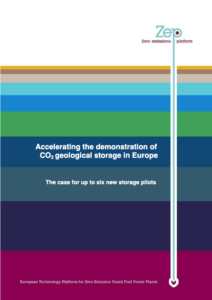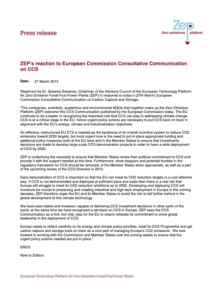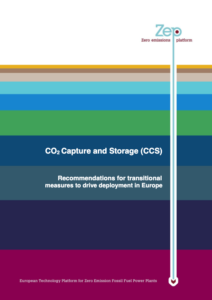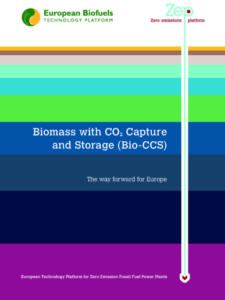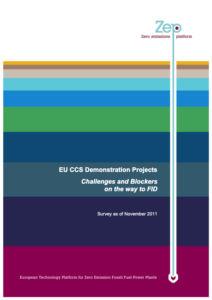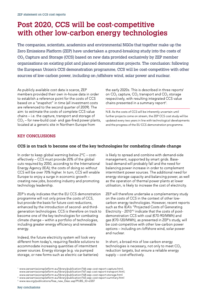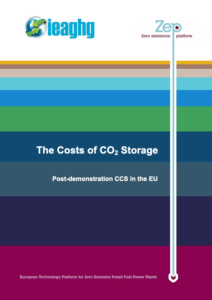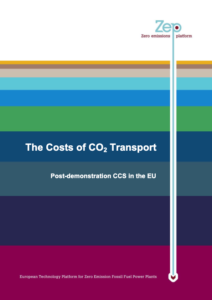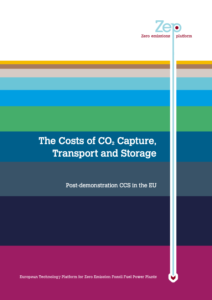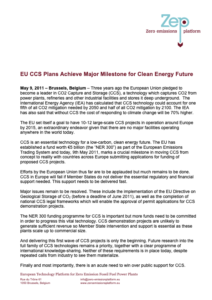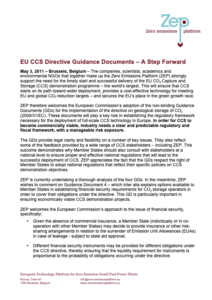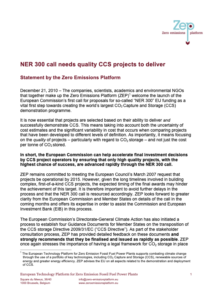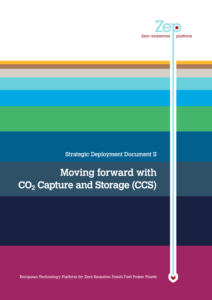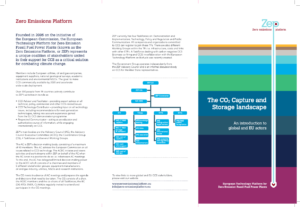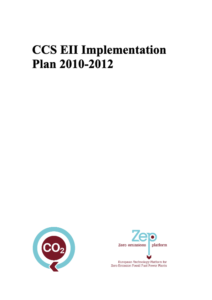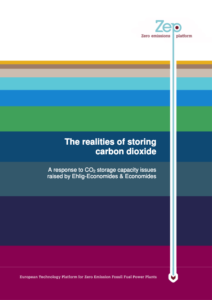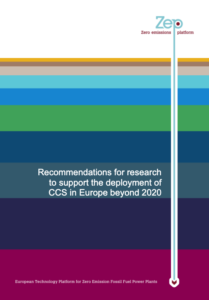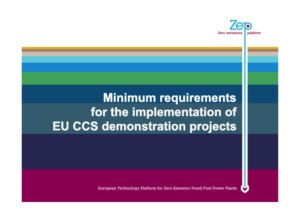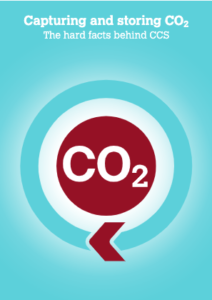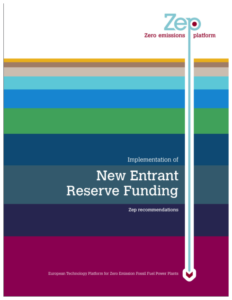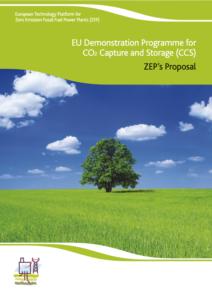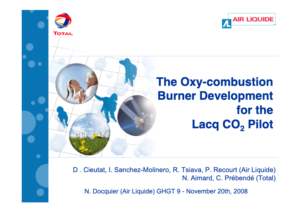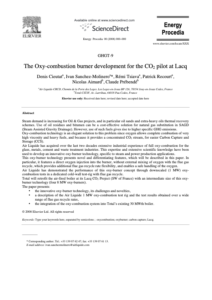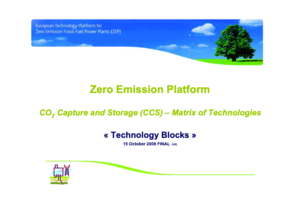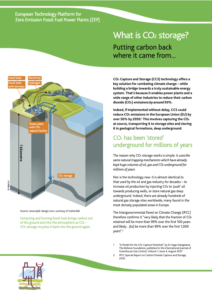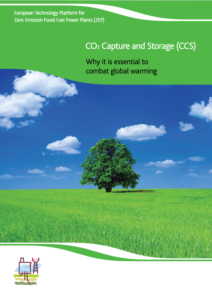| - | Date | Title | Summary |
|---|---|---|---|
ZEP Chairman Dr. Graeme Sweeney spoke at The Economist Energy Summit on November 4th – 5th in London. The Summit brought together energy industry’s stakeholders, including policy-makers and academics. The aim of the high-level event was to provide an insight into what the energy business will look like in 15 years. Dr. Graeme Sweeney took part in a panel discussion entitled ‘Europe’s low-carbon future’. The panel tackled the feasibility of the 2030 framework, which includes the binding target to reduce EU domestic greenhouse gas emissions by at least 40% below the 1990 level. Dr. Sweeney highlighted that CCS is essential to achieving timely and cost-effective decarbonisation. He also stressed that if Europe is to benefit from CCS technology, a business case needs to be made to disrupt the logic that emitting CO2 is cheaper than capturing and storing it. | 27/11/2015 | ZEP Chairman Dr. Graeme Sweeney talks about CCS business case at the Economist Energy Summit | ZEP Chairman Dr. Graeme Sweeney spoke at The Economist Energy Summit on November 4th – 5th in London. The Summit brought together energy industry’s stakeholders, including policy-makers and academics. The aim of the high-level event was to provide an insight into what the energy business will look like in 15 years. Dr. Graeme Sweeney took … |
ZEP modelled the lowest-cost route to decarbonising European by looking at CCS for industries as refining, steel and cement. After modelling the lowest-cost route for decarbonising European power, ZEP turned its attention to industry. With direct industry-related emissions accounting for a quarter of total EU CO2 emissions, it is clear that Europe must look beyond the power sector to include core industries such as refining, steel and cement. Not only is CCS the only option for substantially reducing CO2 emissions in these industries, but the costs of CO2 transport and storage – 10-30% of the total CCS costs – can be significantly reduced by clustering power and industrial emitters. Details and more information in the report (link below). | 12/11/2015 | CCS for industry – Modelling the lowest-cost route to decarbonising Europe | ZEP modelled the lowest-cost route to decarbonising European by looking at CCS for industries as refining, steel and cement. After modelling the lowest-cost route for decarbonising European power, ZEP turned its attention to industry. With direct industry-related emissions accounting for a quarter of total EU CO2 emissions, it is clear that Europe must look beyond the power … |
This is the event page for the 2015 ZEP General Assembly organised in close cooperation with the CCSA, GCCSI and the European Parliament. You will find a livestream of the event on 12 November 2015, from 9:00 to 13:00, on this webpage. Title of the event: Towards a global CCS breakthrough: lessons from abroad and a plan for the EU The event will be a European Parliament hearing. MEPs Theresa Griffin and Krišjānis Kariņšare pleased to invite you to a high level European Parliament hearing on CCS, sponsored by ZEP, CCSA and GCCSI, in association with the Gateway project and the UK Foreign and Commonwealth Office. Find more information here. | 04/11/2015 | Event page ZEP General Assembly 2015: Towards a global CCS breakthrough | This is the event page for the 2015 ZEP General Assembly organised in close cooperation with the CCSA, GCCSI and the European Parliament. You will find a livestream of the event on 12 November 2015, from 9:00 to 13:00, on this webpage. Title of the event: Towards a global CCS breakthrough: lessons from abroad and … |
Emitting CO2 to the atmosphere is currently much cheaper than storing it safely underground. Emitters can pay an ‘ETS wergild’ and are divorced from all the consequences of their actions, yet if they try to sequester CO2 they risk taking on liability for decades under the CO2 Storage Directive. Those factors serve, along with the lack of a near-term business case, to prolong the current inertia on CCS in the EU. Urgent action is now required to deliver CO2 storage projects and enabling infrastructure in preparation for commercial deployment. This requires an Executable Plan, owned by the European Commission. This note (download link below) sketches the contours of such a plan, describing how the Commission can effectively and rapidly aid wide uptake of CCS in Europe; delivering additional CCS projects in power and industry; progressing the development of CCS hubs in Europe; and supporting the appraisal of storage capacity required for commercial CCS deployment. Find it here:
| 17/10/2015 | ZEP Executable Plan for CCS in Europe | Emitting CO2 to the atmosphere is currently much cheaper than storing it safely underground. Emitters can pay an ‘ETS wergild’ and are divorced from all the consequences of their actions, yet if they try to sequester CO2 they risk taking on liability for decades under the CO2 Storage Directive. Those factors serve, along with the lack of a … |
At its meeting of 14 September 2011, ZEP’s Advisory Council agreed to review its strategy in the light of recent developments in the CCS landscape in Europe. This included the perception that fewer demonstration projects may materialise than anticipated – potentially jeopardising the EU CCS demonstration programme. As input to this process, ZEP therefore undertook a survey among project developers in order to identify any challenges and blockers on the way to Final Investment Decision (FID).
| 22/05/2015 | EU CCS Demonstration Projects – Challenges and Blockers on the way to FID | At its meeting of 14 September 2011, ZEP’s Advisory Council agreed to review its strategy in the light of recent developments in the CCS landscape in Europe. This included the perception that fewer demonstration projects may materialise than anticipated – potentially jeopardising the EU CCS demonstration programme. As input to this process, ZEP therefore undertook … |
The revision of the EU Emission Trading System (ETS) is a timely and critical undertaking. ZEP believes that the ETS should remain the principal tool for EU climate policy, providing a predictable, meaningful and robust carbon price and serving as a long-term driver for CCS. It should promote decarbonisation as well as effective funding of low carbon technologies – but due to the low price of allowances and issues with the structure of its funding mechanisms its impact on driving investment in CCS has been limited. ZEP therefore supports both amendments to the ETS structure and a new approach to the funding facilities as critical steps to roll out CCS. This paper was presented to EU Commissioner Cañete (Climate Action & Energy) and EU Commissioner Šefčovič (Vice-President Energy Union).
| 20/05/2015 | ZEP Executable Plan for enabling CCS in Europe (PDF – 872.67kb) | The revision of the EU Emission Trading System (ETS) is a timely and critical undertaking. ZEP believes that the ETS should remain the principal tool for EU climate policy, providing a predictable, meaningful and robust carbon price and serving as a long-term driver for CCS. It should promote decarbonisation as well as effective funding of … |
The critical role of CCS in meeting Europe’s energy, climate and societal goals is now indisputable: the European Commission’s Communication on CCS confirms that it is “vital for meeting greenhouse gas reduction targets”, while the Communication on the 2030 energy and climate framework highlights that CCS “may be the only option available to reduce direct emission from industrial processes at the large scale needed.” As importantly, it will ensure Europe has access to a diverse, reliable and secure energy supply. While attention to date has focused on the emitting part of the CCS chain (CO2 capture), large-scale CCS requires CO2 transport and storage infrastructure – at the right time, in the right place, at the right capacity. In the current policy environment, there is no indication this will happen. There is a dearth of companies developing storage sites. Innovative business models are therefore needed which align commercial interests across the entire CCS chain; and given the long lead times – 6 to 10 years for both pipelines and storage sites – development needs to start now, ahead of wide-scale deployment. Indeed, having a framework in place which enables storage projects to be established with the confidence that then also enables investment in CO2 capture is critical to the timely deployment of CCS in Europe. The question is: “What is needed to make CO2 transport and storage a viable business?” In order to answer it, ZEP created a dedicated taskforce of experts representing a broad cross-section of the CCS value chain, including industry, academia and NGOs. Their conclusions – and solutions – are outlined in this groundbreaking report. Download ZEP’s report here: | 14/11/2014 | ZEP report on Business Models for Commercial CO2 Transport and Storage | The critical role of CCS in meeting Europe’s energy, climate and societal goals is now indisputable: the European Commission’s Communication on CCS confirms that it is “vital for meeting greenhouse gas reduction targets”, while the Communication on the 2030 energy and climate framework highlights that CCS “may be the only option available to reduce direct … |
In order to identify how low-carbon technologies can reduce European power emissions most cost-effectively in the horizon to 2050, the Zero Emissions Platform (ZEP) has developed a model based on an existing model from the Norwegian University of Science and Technology (NTNU) and linked it to the Global Change Assessment Model (GCAM). ZEP’s model is designed to select the lowest-cost investments to meet expected electricity demand, while replacing plants that exceed a defined lifetime – country by country. It is unique in that it not only takes into account optimised operating costs hour-by-hour, but also has a dispatch model for renewable power based on capacity factors and historic weather data. Download ZEP’s report here: | 14/11/2014 | ZEP’s model shows the lowest-cost route to decarbonising European power | In order to identify how low-carbon technologies can reduce European power emissions most cost-effectively in the horizon to 2050, the Zero Emissions Platform (ZEP) has developed a model based on an existing model from the Norwegian University of Science and Technology (NTNU) and linked it to the Global Change Assessment Model (GCAM). ZEP’s model is … |
Welcome to the event page of the ZEP European Parliament Hearing on CCS and industrial growth, taking place on 10 November 2014 in Room P7C050 at the European Parliament in Brussels. This event is also known as the 2014 ZEP General Assembly. Twitter hashtag for the event is #CCS4GROWTH. This event, hosted by MEP Theresa Griffin, features a keynote from Jos Delbeke, Director General of DG CLIMA and an interactive debate brining together Jerzy Buzek, our ITRE Chairman, alongside representatives from the industry and NGO sectors. Watch videos of the event here: Panel 1 “What can CCS mean for the industrial sector?”: Panel 2 “Policy perspectives to kick-start CCS in Europe”: As the EU debates its decarbonisation targets for 2030 we must stimulate growth and put in place measures that can address both competitiveness and sustainability. The question however is – how can we ensure that European heavy industry can compete, when subject to low carbon targets, while safeguarding jobs? The Zero Emission Platform, which sponsors the event, will present reports to stimulate debate. Carbon Capture and Storage is the only decarbonisation option available for many industrial sectors and is critical to ensuring a cost effective decarbonisation of our power sector by 2050. This hearing is about understanding, sharing and exchanging ideas on how we can enable CCS in industry and power. Full programme: 12:00 Opening by host MEP Theresa Griffin 12:15 Keynote speech by Jos Delbeke, Director General, DG CLIMA 12:30 Panel debates moderated by Jill Duggan, Senior Associate, University of Cambridge Institute for Sustainability Leadership (SISL) Panel debate 1: What can CCS mean for the industrial sector? – Gardiner Hill, Director Carbon Solutions, BP – Philip Pearson, Senior Policy Officer, ETUC – Frederic Hauge, Founder and President, The Bellona Foundation – Koen Coppenholle, Chief Executive, The European Cement Association Panel debate 2: Policy perspectives to kick-start CCS in Europe – Dr. Graeme Sweeney, Chairman of the Advisory Council of ZEP – Amy Clemitshaw, Deputy Director, Fossil Fuel Generation and CCS Policy, UK DECC – Jos Delbeke, Director General, DG CLIMA – MEP Jerzy Buzek, Chair of the ITRE Committee 14:15 Closing remarks by EP Edouard Martin and MEP Theresa Griffin | 07/11/2014 | Event page: European Parliament Hearing on Carbon Capture & Storage (CCS) – An essential part of Europe’s industrial growth equation | Welcome to the event page of the ZEP European Parliament Hearing on CCS and industrial growth, taking place on 10 November 2014 in Room P7C050 at the European Parliament in Brussels. This event is also known as the 2014 ZEP General Assembly. Twitter hashtag for the event is #CCS4GROWTH. This event, hosted by MEP Theresa … |
On 24 September 2014, MEP Judith Kirton-Darling hosted a Breakfast Briefing in the European Parliament on Carbon Capture & Storage and Energy security, which was co-hosted by MEP Krišjānis Kariņš and organised by the Zero Emissions Platform (ZEP). The programme included the following speakers: MEP Jude Kirton-Darling (S&D, UK); Paula Abreu-Marques, Head of Unit Renewables and CCS Policy, DG Energy (European Commission); Dr Graeme Sweeney, Chairman of ZEP; Dr Reinhold Elsen, Vice Chair ZEP and Vice President Research & Development, RWE; Dzintars Kauliņš, Energy Counsellor at the Latvian Permanent Representation to the EU; Jonas Helseth, Director at The Bellona Foundation; and MEP Krišjānis Kariņš (EPP, LV). Download the event report below.
Interventions MEP Jude Kirton-Darling (S&D, UK) praised the achievements of ZEP, stressing that it is a key platform to support the CCS agenda. She called on the members of ZEP to continue their efforts to raise awareness on CCS in the recently renewed European Parliament, especially ahead of the upcoming debates on the 2030 energy and climate package.
Paula Abreu-Marques, Head of Unit Renewables and CCS Policy, DG Energy (European Commission) welcomed the continuation of the European Parliament’s interest in CCS. Furthermore, she stressed that CCS must remain a key component in Europe’s energy security strategies, as it is offers the solution to maintain a diversified energy mix while supporting Europe’s climate commitments. She called on the Informal Energy Council and on the European Council to extend their support to CCS within the 2030 discussions, adding that the role of Member States and of the private sector will be key to enabling the deployment of CCS. Dr Graeme Sweeney, Chairman of ZEP, highlighted the contribution of CCS to a secure, affordable and sustainable European energy system. Calling for a robust CO2 price, Dr Sweeney stressed that CCS will be key to meeting the 2050 climate objectives in a cost effective way, while helping to maintain jobs and industrial basis in Europe. He called on the European institutions to renew their support to CCS in order to give Europe its leadership back, stressing that regions such as Canada have now overtaken Europe in terms of CCS deployment.
Dzintars Kauliņš, Energy Counsellor at the Latvian Permanent Representation to the EU, described the completion of the European Internal energy Market, the European Energy Security Strategy and the 2030 energy and climate framework as the three tentative priotirites within the energy policy of the upcoming Latvian Council Presidency. While recognising the role of CCS within the 2020 energy and climate package, Mr Kauliņš stressed that the presence of three different targets ended up diluting support for CCS. He highlighted that more support for CCS would be easier to achieve in case of a single CO2 target for 2030. Jonas Helseth, Director at The Bellona Foundation, outlined why an environmental NGO sees the rollout of CCS in Europe as necessary to reach Europe’s energy and climate targets. He stressed the potential of both CCS and renewables in addressing the climate change challenges while generating economic benefits for Europe. He further made the point that CCS is the only technology that can reduce inherent emissions of energy intensive industries as well as lead to carbon negative emissions in combination with sustainable bioenergy, highlighting ZEP’s two reports on these areas. Closing the debate, MEP Krišjānis Kariņš (EPP, LV) stressed the urgent need to reduce greenhouse gas emissions. While recognising the potential of renewables in addressing climate change, he stressed that CCS will allow for the use of a more diversified energy mix while making progress towards reaching Europe’s climate objectives. Concluding that CCS must benefit from a high carbon price, he questioned how far public intervention can go in terms of modifying the current state of the EU ETS and called for a broad and integrated vision of the future EU energy and climate policy framework, including economic parameters and industrial competitiveness.
| 14/10/2014 | Event page: European Parliament Breakfast Briefing on Carbon Capture & Storage and Energy Security Event Conclusions | On 24 September 2014, MEP Judith Kirton-Darling hosted a Breakfast Briefing in the European Parliament on Carbon Capture & Storage and Energy security, which was co-hosted by MEP Krišjānis Kariņš and organised by the Zero Emissions Platform (ZEP). The programme included the following speakers: MEP Jude Kirton-Darling (S&D, UK); Paula Abreu-Marques, Head of Unit Renewables … |
Together with renewables and energy efficiency, CCS is a key technology to improve EU energy independence, diversity and security of supply while achieving climate objectives in an affordable manner and contributing to EU economic growth and competitiveness. Deployed in power generation (coal and gas) and energy intensive industries, CCS will ensure that the EU uses an energy which is clean, affordable and reliable, exploiting local and diversified fossil fuel resources effectively, both in terms of cost and environmental impact. The development and deployment of CCS technologies in Europe is therefore imperative. Download the full statement from ZEP below. 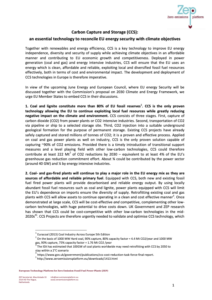 CCS: an essential technology to reconcile EU energy security with climate objectives (PDF – 346.69kb)
| 03/07/2014 | CCS: an essential technology to reconcile EU energy security with climate objectives | Together with renewables and energy efficiency, CCS is a key technology to improve EU energy independence, diversity and security of supply while achieving climate objectives in an affordable manner and contributing to EU economic growth and competitiveness. Deployed in power generation (coal and gas) and energy intensive industries, CCS will ensure that the EU uses … |
In 2010, ZEP published its landmark report, “Recommendations for research to support the deployment of CCS in Europe beyond 2020”, which identified key R&D areas requiring support in order to drive down costs and accelerate deployment via well-targeted programmes. FP7-ENERGY calls have taken into account several key recommendations, proving various individual components of the CCS value chain. Much learning has been achieved and industry is today confident that CO2 transport and storage can be safely introduced on a commercial scale. However, further targeted R&D is essential in areas that can significantly reduce costs and commercial risks. ZEP has therefore published an update on R&D priorities for CO2 capture, while this report covers R&D priorities for CO2 transport and storage, taking into account advances achieved to date. (N.B. These are prioritised independently of the source of capture.) ZEP has also published a separate report outlining the urgent need for up to six new large storage pilots, EU-wide. Work on R&D priorities must be initiated now and/or continued in order to enable the wide deployment of CCS by 2030. This includes all the key development steps (laboratory – small/large pilot – demonstration – pre-commercial). To this end, CCS must be fully represented in Horizon 2020 as a critical low-carbon technology for delivering EU climate goals. Download the ZEP report below. | 18/02/2014 | ZEP Long-term research priorities CCS transport and storage | In 2010, ZEP published its landmark report, “Recommendations for research to support the deployment of CCS in Europe beyond 2020”, which identified key R&D areas requiring support in order to drive down costs and accelerate deployment via well-targeted programmes. FP7-ENERGY calls have taken into account several key recommendations, proving various individual components of the CCS … |
EU must be more ‘ambitious’ on rolling-out CCS The commission’s 2030 climate and energy package ‘underscores’ the value of carbon capture and storage (CCS), but measures must be taken to make it financially viable, says Graeme Sweeney. The European commission and European parliament have invested great efforts in driving the debate around climate change goals for 2030. We now have a framework proposal that provides a strong foundation for achieving these goals and developing a competitive low-carbon economy. That the proposal underscores the value of CCS in achieving climate change targets is a significant step in the right direction. However, we must not become complacent and fail to introduce the policy elements that will facilitate a successful future for CCS. At the core of the commission’s proposal is the target to reduce EU domestic greenhouse gas (GHG) emissions by 40 per cent below 1990 levels by 2030, which is a positive step towards the goal of an 80 to 95 per cent reduction by 2050. The commission’s renewed commitment to CCS, particularly underlining its value for decarbonising the European power sector and carbon-intensive industries, emphasises the significant role CCS must play in meeting this target. Zero emissions platform (ZEP) research has already demonstrated that the power sector in Europe cannot be cost-effectively decarbonised without CCS, and that it is crucial for maintaining jobs and preserving the industrial base, as it is the only decarbonisation option for many energy-intensive industries. We urgently need EU transitional support measures and an ambitious milestone for CCS if we are to create the right environment for the technology to flourish. While the 2030 framework proposal calls for increased research and development efforts and commercial demonstration projects in CCS we need an ambitious EU milestone that would provide the necessary level playing field vis-à-vis other low-carbon technologies. Beyond this, careful consideration must be given to the proposed new governance structure. National plans should be considered in the context of a milestone for CCS. They will also need to be flexible enough to allow member states to achieve their GHG reduction ambitions using the technology which is most appropriate for their circumstances, allowing room for CCS where desired. Looking to the future, the emissions trading system should remain the central tool of EU climate policy. But we will need structural measures that will reduce emissions costs effectively and provide a predictable and robust carbon price, triggering investments in low-carbon technologies, such as CCS. A timely cap on the number of emission allowances flowing through the market in 2030 is a priority in this regard. Transitional support measures are crucial. Our research clearly shows that the carbon price will still be too low in the 2020s to drive the roll-out of CCS. Well designed measures, such as a CCS fund, feed-in-premia or even a CCS certificate scheme will be necessary for the roll-out. The CCS industry needs clear signals from policy makers to ensure a strong business case and tackle funding and infrastructure gaps as well as bureaucratic obstacles. There is no question CCS can deliver and, with the council meeting in March fast approaching, the moment is right for member states to create the necessary environment for the deployment of this essential technology. Graeme Sweeney is chairman of the zero emissions platform (ZEP) | 14/02/2014 | Graeme Sweeney: "EU must be more ‘ambitious’ on rolling-out CCS" | EU must be more ‘ambitious’ on rolling-out CCS The commission’s 2030 climate and energy package ‘underscores’ the value of carbon capture and storage (CCS), but measures must be taken to make it financially viable, says Graeme Sweeney. The European commission and European parliament have invested great efforts in driving the debate around climate change goals … |
This is the event page for the 2013 ZEP General Assembly: a Public Hearing in the European Parliament to discuss ways of Unlocking the potential of CCS through the EU 2030 climate and energy framework. Find below the different videos of the event. This event took place on 26 November 2013. Video 1 of 7: Welcome remarks by MEP Jerzy Buzek, MEP Chris Davies and MEP Teresea Riera Madurell. Speech by Marie Donnelly, Director of European Commission’s Energy DG, new and renewable sources of energy, energy efficiency and innovation.
ZEP GA 1 of 7 from ZEP – Zero Emissions Platform on Vimeo. Video 2 of 7: Speech by Dr. Graeme Sweeney, Chairman of the Zero Emissions Platform.
ZEP GA 2 of 7 from ZEP – Zero Emissions Platform on Vimeo. Video 3 of 7: Panel 1 “CCS: a critical component in the 2030 climate and energy framework”. Speech by Piotr Tulej, Head of Unit European Commission’s DG Climate Action, low carbon technologies. Speech by Didier Houssin, IEA Director of Sustainable Energy Policy and Technology.
ZEP GA 3 of 7 from ZEP – Zero Emissions Platform on Vimeo. Video 4 of 7: Panel 1 “CCS: a critical component in the 2030 climate and energy framework”. Speech by Tony Ripley, UK Department of Energy & Climate Change. Speech by Charles Soothill Senior Vice President of Alstom.
ZEP GA 4 of 7 from ZEP – Zero Emissions Platform on Vimeo. Video 5 of 7: Panel 1 “CCS: a critical component in the 2030 climate and energy framework”. Q&A session.
ZEP GA 5 of 7 from ZEP – Zero Emissions Platform on Vimeo. Video 6 of 7: Panel 2 “CCS for the economic and social agenda”. Speech by Andrew Purvis, General Manager EMEA, GCCSI. Speech by Philip Pearson, Senior Policy Officer, Economic Department of the TUC, UK. Speech by Marek Ściążko, Institute for Chemical Processing of Coal, Poland.
ZEP Ga 6 of 7 from ZEP – Zero Emissions Platform on Vimeo. Video 7 of 7: Panel 2 “CCS for the economic and social agenda”. Speech by Frederic Hauge, President of Bellona Europa. Closing remarks by MEP Chris Davies.
ZEP GA 7 of 7 from ZEP – Zero Emissions Platform on Vimeo. The hearing was hosted by MEPs Jerzy Buzek (EPP, Poland), Chris Davies (ALDE, UK) and Teresa Riera Madurell (S&D, Spain), making this a truly cross party and cross party event which will see the participation of several high-level speakers from the EU institutions, international organisations, industry and ZEP. CCS was discussed as a critical component in the upcoming EU climate and energy framework for 2030, as well as a key contributor to the economic and social agenda in Europe. Find the programme and information about ZEP taskforces below.
| 18/11/2013 | Event page ZEP European Parliament Public Hearing (aka 2013 General Assembly) | This is the event page for the 2013 ZEP General Assembly: a Public Hearing in the European Parliament to discuss ways of Unlocking the potential of CCS through the EU 2030 climate and energy framework. Find below the different videos of the event. This event took place on 26 November 2013. Video 1 of 7: … |
CO2 Capture and Storage (CCS) will play a critical role in meeting Europe’s energy, climate and societal goals, but its demonstration is essential to achieve commercial availability and public support, and to allow it to be widely applied “from around 2030 onwards”. CCS has reached a ‘tipping point’ in Europe and urgent action is needed at EU and Member State level to deliver a sufficient set of demonstration projects. In this position paper, ZEP reflects on what should be considered an appropriate pace to scale up CCS demonstration between now and 2030 to ensure sufficient ramp-up towards commercial deployment and avoid continued overall uncertainty, higher costs and the effects of carbon lock-in. CCS demonstration will require Policy and Regulation within the EU and ZEP’s views on these requirements are reflected in other ZEP publications, notably its responses to the European Commission’s “Green Paper” and “Communication on CCS”
| 17/11/2013 | The Case for Urgent Action on CCS in Europe | CO2 Capture and Storage (CCS) will play a critical role in meeting Europe’s energy, climate and societal goals, but its demonstration is essential to achieve commercial availability and public support, and to allow it to be widely applied “from around 2030 onwards”. CCS has reached a ‘tipping point’ in Europe and urgent action is needed at … |
The European Commission has confirmed that Europe cannot be decarbonised cost-effectively – and maintain security of energy supply – without CO2 Capture and Storage (CCS). Indeed, with fossil fuels currently meeting over 80% of global energy demand and as much as 85 GW of additional capacity expected in Europe alone, CCS is “vital for meeting the Union’s greenhouse gas reduction targets”. Yet the benefits of CCS go far beyond that of climate change mitigation: with annual investments worth billions of euros, CCS will create and preserve jobs, boost industry and fuel economic growth, ensuring Europe remains competitive on the world stage as a leader in low-carbon energy technologies. In order to identify how low-carbon technologies can decarbonise European power most cost-effectively in the horizon to 2050, the Zero Emissions Platform (ZEP) has developed a model based on an existing model from the Norwegian University of Science and Technology (NTNU) and linked to the Global Change Assessment Model (GCAM). ZEP’s model is designed to select the lowest-cost investments to meet expected electricity demand, while replacing plants that exceed a defined lifetime – country by country. It is unique in that it not only takes into account optimised operating costs hour-by-hour, but a dispatch model of renewable power2 based on capacity factors and historic weather data. | 17/11/2013 | CO2 Capture and Storage: Recommendations for transitional measures to drive deployment in Europe | The European Commission has confirmed that Europe cannot be decarbonised cost-effectively – and maintain security of energy supply – without CO2 Capture and Storage (CCS). Indeed, with fossil fuels currently meeting over 80% of global energy demand and as much as 85 GW of additional capacity expected in Europe alone, CCS is “vital for meeting the … |
The European Commission has confirmed that Europe cannot be decarbonised cost-effectively – and maintain security of energy supply – without CCS. Yet its benefits go far beyond that of climate change mitigation: with annual investments worth billions of euros, CCS will create and preserve jobs, boost industry and fuel economic growth, ensuring Europe remains competitive on the world stage as a leader in low-carbon energy technologies. But the window of opportunity is closing fast. In order for CCS to be widely deployed by 2030 – and deliver EU climate targets – the following is urgently required:
Download ZEP’s position paper below. | 16/11/2013 | ZEP strategy paper: maintaining the momentum to deliver energy, climate and societal goals | The European Commission has confirmed that Europe cannot be decarbonised cost-effectively – and maintain security of energy supply – without CCS. Yet its benefits go far beyond that of climate change mitigation: with annual investments worth billions of euros, CCS will create and preserve jobs, boost industry and fuel economic growth, ensuring Europe remains competitive … |
The critical role of CO2 Capture and Storage (CCS) in meeting the EU’s energy, climate and societal goals is now indisputable: the European Commission’s Communication on CCS has confirmed that is not only “vital for meeting the Union’s greenhouse gas reduction targets”, it provides a “very visible link between jobs in local communities and continued industrial production”. Indeed, CCS must account for 19-32% of total emissions reductions in the power sector by 2050, which means that “For all fossil fuels, Carbon Capture and Storage will have to be applied from around 2030 onwards”. Ongoing R&D for CCS is essential in order to drive down costs, and deliver EU climate targets. This report therefore prioritises immediate R&D needs of CO2 capture, focusing mainly on the power sector, while identifying the need to verify industrial applications – taking into account advances achieved to date and future requirements to drive down costs. | 14/10/2013 | ZEP report on long-term R&D priorities for CCS: Capture | The critical role of CO2 Capture and Storage (CCS) in meeting the EU’s energy, climate and societal goals is now indisputable: the European Commission’s Communication on CCS has confirmed that is not only “vital for meeting the Union’s greenhouse gas reduction targets”, it provides a “very visible link between jobs in local communities and continued industrial … |
Recent setbacks for carbon capture and storage (CCS) technology underline the need for realistic ambition, innovative funding and urgent regulatory action, argues Graeme Sweeney. He was talking to EurActiv’s senior journalist, Arthur Neslen How big a blow was the recent decision in Norway to end the Mongstad project. Oslo has led the way in CCS development. Is this a major setback for CCS technology in Europe? It’s a disappointment that that project isn’t going to proceed. To understand exactly why that’s occurred you probably need to wait a bit to be clearer or to be much closer to the details which I’m not privileged to be. I was encouraged that at same time, the Norwegian government suggested that it would be looking at an alternative project at one sort or another. It is part of a pattern of things which tells us that we need a reset around how we try to progress CCS. That’s the key message. We need to think carefully about how many end-to-end projects we may reasonably have. We have to think about the role of other approaches to developing the technology and we have to be clear about what sorts of timelines there are for its development. Are there are any more optimistic signs on the horizon for CCS in Europe at the moment? We should continue to be strongly encouraged by the UK government’s approach. We’ve seen there the competition progress to two projects now in negotiation on their feeds. Perhaps more significantly, we’ve heard them say that the contracts for difference could apply to projects that are outside of the competition itself – and there are two or three of those, and of course White Rose is still a candidate under the NER300 – so I think that is clearly a well-progressed regime and has some clear choices around instruments which may deliver the project capacity. There’s a lesson in that which we just draw in general. There will be a need for specific transition al support and that will require – while it is clear that capital grants are valuable – more than that to make these things happen and the UK has chosen contracts for difference and those have always figured in our view of what are effective means going forward for effective transitional support. What about at the global level? We shouldn’t lose sight of the fact that progress continues to be made in the US and in Canada – particular with the Quest project. In Alberta? Yes in Alberta, that’s correct. And I will always remind us that under construction in North West Australia we have a substantial project and while the exact amount of CO2 that may be stored will depend on the production regime that we’re looking at three or four million tonnes going into the offshore saline aquifer in the Gorgon project. It is also significant that we see action in China, that there is a clear place for CCS in the forward five-year-plan. So I think there is an opportunity and the other part of it is this. There will be a limited set of end-to-end full chain CCS demonstration projects in Europe. In part that is because the appetite of all parts for risk of all the participants has changed due to the economic crisis and it is a reflection of where we are in terms of project development. But I think we will have some. We have Sleipner and Synervit in Norway and we may well have the ROAD project in the Netherlands. We will get some. I think. They will need to be complimented by substantial work on the storage options and so I’m pleased to see that in the Horizon 2020 programme, there is a clear emphasis on the storage and infrastructure story and as Connecting Europe progresses, you will see that there is provision there for infrastructure for CO2 and I would like in due course there to see a call for the development of CCS infrastructure. Those are all options we need to build into our action over the next five years or so. We also need to take a view on the role that CCS will have from a European perspective in the 2030 framework and beyond. We have all made the economic case before. If you want to decarbonise the power sector, we know that it will be 40% cheaper if we include CCS, than if we exclude it. We know that it is likely that fossil fuels will be a substantial part of the energy mix going forward and we know that CCS is the technology that can decarbonise that part cost-effectively and create jobs in the industry itself and at the same time, creates the opportunity to retain jobs in the emissions-intensive industries like steel, cement and aluminium. It sounds like a reduction in ambition We have what we have and we need more. We need a policy reset on what we want to do in the 2020s. The first step is that CCS has to be a key component of the 2030 framework and then settle the matter through the CCS Consultative Communication of what instruments may make that happen. That is the DG Clima and Energy consultation on the future of CCS, which asked a whole range of questions in the consultation. When is that due out? The timeline is that their review of everyone’s input should be done by December. It all should form part of the input to the Energy Council in December and the Environment Council at the same time. Within that they ask for views on whether or not feed-in tarrifs (FITs) are applicable and useful and the ZEP view is that premium FITs which limit the exposure of all parties are a very effective way of delivering volumes of CCS. They also asked about an innovation fund and ZEP supports that too. You could think of that as a larger-scale version of the NER300 funded by EU aid but it also makes the point that you will need operational support and you wll need to dispatch the plants if they get built, so here is a range of things. There is also a conversation on whether the CCS certification scheme could be useful. We believe that carefully designed and for a defined volume, such a scheme could produce incremental CCS in the 2020s. We need to settle what we intend to do there> the other opportunity we have is the own initiative report in the parliament. We have to have an ambitious milestone in 2030 because that is what persuades us to have an instrument in the 2020s, so that the ETS recovers to be the main deliverer of decarbonisation thereafter. What gets included in the 2030 energy targets and becomes part fo the Whiet Paper will set the direction for the success of Commission and Parliament. It is also clear that there is an aspiration from the Commission and you heard that from President Barroso himself to have at least some sort of legislative proposal in place before the end of the year. So we are all working hard to understand where that may take us. You have said before that the EU’s decarbonisation won’t be possible unless we have CCS for gas. What about CCS for coal and for oil, is that an equally important priority? Certainly for coal – and we would argue for both lignite and hard coal – they would be part of the preferred energy mix if you like. Yes, important for all three but certainly, for gas as well. Well what about the criticism then that you are encouraging money being diverted away from renewables that could reduce emissions today, to build lock-ins of fossil fuels from the past, for a technology that may never even be developed in time to allow any real CO2 savings benefits at all in the future? Indeed, I do hear those storylines. The first thing is that we do not position ourselves as competing with renewables. We believe that the forward energy generation mix will contain a very high proportion of renewables and you can a long conversation about what you mean by ‘very high’ but that is not the point. We understand, recognise and believe that it is part of the preferred solution. But in addition to that, to have a secure, reliable and affordable total energy system, you need the CCS and we know the work that’s been done by the IEA has confirmed this over again. They have their seven points which all need to be done, and CCS is clearly one. So we are in favour of a balanced generation system which includes renewables but we believe that the lowest cost route to decarbonisation for the power sector will undoubtedly be for the significant deployment for perhaps a fifth of emissions, from CCS. For the emissions intensive industries, particularly where the emissions are associated with the industrial process itself, CCS will be equally essential for meeting the decarbonisation targets. So it is clear that we should invest the time to make this work, and we welcome the time that has been spent to make sure that the renewables systems work. How do you get around public acceptance issues? I think it is clear that onshore storage is unlikely to be available in the short run given the concerns that have been expressed. We need to do two things. One, we need to take advantage of the offshore to build expertise and confidence and we need to position some significant but smaller-than-small-scale projects in onshore to drive confidence. We believe we can do that that you need to show people that it works. What is the latest that you are hearing about the next round of the NER300 awards? We are not privileged to be part of the evaluation process so you probably know as much as I do. We know that there is one candidate project in the CCS space and all the folks involved are doing their level best to make sure that it gets through the qualification, but I don’t have anything beyond that. Is more attention needed from the Commission to addressing issues like a legal framework for allowing the cross-border transport and storage of CO2? We have just written to Commissioner Hedegaard on the matter of transposition of the [CCS] directive which is important, particularly in terms of liabilities. We also have a clearly articulated position that we need to resolve the issues around the London Protocol because those indeed inhibit the cross-border distribution of materials. There are a number of things of that kind that have to be resolved to make the industry as a whole work satisfactorily and I agree that that is work that needs to be done. And in terms of those countries which are yet to transpose and implement the CCS Directive, some of which are even hosting international climate talks, would you like to see the EU getting a bit tougher with them? Yes, we believe that the directive should be appropriately transposed by all member states and from a pragmatic perspective, we recognise that for those member states where we are likely to see any significant action over the next one or two years, that transposition has occurred. But I agree that we need to see the directive transposed. | 11/10/2013 | Graeme Sweeney: "We must reset our approach to CCS" | Recent setbacks for carbon capture and storage (CCS) technology underline the need for realistic ambition, innovative funding and urgent regulatory action, argues Graeme Sweeney. He was talking to EurActiv’s senior journalist, Arthur Neslen How big a blow was the recent decision in Norway to end the Mongstad project. Oslo has led the way in CCS … |
The 2013 edition of ZEP’s General Assembly will take the form of a Public Hearing in the European Parliament to discuss ways of Unlocking the potential of CCS through the EU 2030 climate and energy framework. The hearing will be hosted by MEPs Jerzy Buzek (EPP, Poland), Chris Davies (ALDE, UK) and Teresa Riera Madurell (S&D, Spain), making this a truly cross party and cross party event which will see the participation of several high-level speakers from the EU institutions, international organisations, industry and ZEP. CCS will be discussed as a critical component in the upcoming EU climate and energy framework for 2030, as well as a key contributor to the economic and social agenda in Europe. The event will take place on 26 November 10h00-12h00, and will be followed by a networking lunch until 13h30. Practical information
Interested in further information or in attending the event? Please send an email to the ZEP Secretariat: info@zero-emissionplatform.eu.
| 09/10/2013 | European Parliament Public Hearing – Unlocking the potential of CCS through the EU 2030 climate and energy framework | The 2013 edition of ZEP’s General Assembly will take the form of a Public Hearing in the European Parliament to discuss ways of Unlocking the potential of CCS through the EU 2030 climate and energy framework. The hearing will be hosted by MEPs Jerzy Buzek (EPP, Poland), Chris Davies (ALDE, UK) and Teresa Riera Madurell … |
ZEP has published a paper outlining the potential of CO2 Capture and Use (CCU) and CO2 Capture Use and Storage (CCUS) not only to reduce CO2 emissions, but accelerate CCS deployment, e.g. via the combination of CCS with Enhanced Oil Recovery (EOR), geothermal heat production, CO2 mineral storage etc. Indeed, CCU could add significant economic value to a CCS project – even if there is only temporary ‘storage’ of CO2. The greatest potential in Europe is offshore EOR, mainly in the North Sea and in Eastern Europe. Urgent action is therefore needed to exploit the full potential of CCU/CCUS:
Download ZEP’s paper below.
| 30/09/2013 | CO2 Capture and Use (CCU) | ZEP has published a paper outlining the potential of CO2 Capture and Use (CCU) and CO2 Capture Use and Storage (CCUS) not only to reduce CO2 emissions, but accelerate CCS deployment, e.g. via the combination of CCS with Enhanced Oil Recovery (EOR), geothermal heat production, CO2 mineral storage etc. Indeed, CCU could add significant economic value to a CCS … |
In its EU Energy Roadmap 2050, the European Commission recognises that Carbon Capture and Storage (CCS) is the only technology available to mitigate CO2 emissions from large-scale fossil fuel use. The EU badly needs a successful CCS programme by 2020 and can no longer afford delays, writes Graeme Sweeney. This article originally appeared on the website of EurActiv. With the world population expected to reach 9 billion by 2050, global energy demand is projected to rise by 40% over the next two decades alone. To meet this demand the International Energy Agency (IEA) forecasts that 75% of all energy will still be derived from fossil fuels in 2035, significantly contributing to rising CO2 emissions. The EU Energy Roadmap 2050 set out objectives for reducing greenhouse gas emissions to 80-95% below 1990 levels by 2050. In this Roadmap, the European Commission recognised that Carbon Capture and Storage (CCS) is the only technology available to mitigate CO2 emissions from large-scale fossil fuel use across a wide range of industries. Without CCS, Europe will miss its 2050 objectives. CCS is indispensable to decarbonising power generation and energy intensive industries including iron, steel and cement. By applying CCS, it becomes possible to reduce full life-cycle CO2 emissions from fossil-fuel combustion at power stations and industrial sites by 65-85%. According to the IEA, delaying CCS deployment by just 10 years would increase the cost of decarbonising the global power sector by over €750 billion. These numbers underline the grave economic impact of failing to quickly deliver CCS. We need a successful CCS demonstration programme by 2020 to reach our long-term decarbonisation goals. Demonstration projects will allow CCS to become cost effective and competitive with other low carbon technologies which will essentially drive down costs. However, we must consider the time necessary to achieve the needed capacity and infrastructure. The IEA has stressed that the next seven years will be critical to the accelerated development of CCS. Failing to act now is taking a major gamble. The technology is indeed available today, but we cannot be complacent about the need to deploy and optimise CCS technology. A Europe with CCS cannot be built overnight. If CCS is essential for achieving EU decarbonisation goals, it is also providing a vast potential for economic growth and jobs. The development of CCS core infrastructure will ensure a stream of high quality work for a skilled workforce for many years to come, along with the potential to export our know-how derived from these projects around the globe. In the UK alone, CCS clusters could create 27,000 jobs from 2020 rising up to 70,000 jobs by 2035. However, the EU is currently falling behind on the commitments needed to secure the deployment of necessary CCS projects. The Green Paper on the EU 2030 Energy and Climate Policy framework has failed to reflect the urgency for this ground-breaking and unequivocal technology. What Europe needs is an immediate reset and a comprehensive and coordinated approach to setting in motion the roll-out of CCS. First and foremost, the EU 2030 Energy and Climate Policy Framework needs to fully integrate CCS and provide a long-term signal for investors. Member States should be required to develop roadmaps and national strategies for achieving decarbonisation targets, similar to those set for the renewables sector. The ETS should remain the central tool of EU climate policy, providing a predictable and robust carbon price and a long term driver for CCS. However, further structural measures and a tightened cap in 2030 will be needed to strengthen the EU ETS in the long term. We will first need short-term measures to support CCS demonstration and early deployment projects until CCS becomes commercially viable, such as Feed In Tariffs (FiTs) at Member State level. Where FiTs are not possible, CCS certificates could be an option, if carefully designed for a defined volume. But predictable long term financial incentives and a regulatory framework that is fit-for-purpose will also be essential. If urgent policy action is taken, CCS can still be widely deployed by 2030 but the window of opportunity is closing fast. As Member States enter the debate over the 2030 Energy and Climate Policy framework, they should consider that failing to act now will mean Europe will miss its ambitious 2050 decarbonisation goals. It will also cost Europe an additional €75 billion to address climate change – while damaging its competitiveness and missing out on huge potential job creation and economic growth. Business-as-usual is not an option. This is the moment to reset EU energy and climate policy by kick-starting European CCS development.
| 17/09/2013 | Re-setting the way to a decarbonised Europe | In its EU Energy Roadmap 2050, the European Commission recognises that Carbon Capture and Storage (CCS) is the only technology available to mitigate CO2 emissions from large-scale fossil fuel use. The EU badly needs a successful CCS programme by 2020 and can no longer afford delays, writes Graeme Sweeney. This article originally appeared on the website … |
Dr. Graeme Sweeney, is the chairman of the European Technology Platform for Zero Emission Fossil Fuel Power Plants (ZEP). This article originally appeared in EurActiv. It was rightly considered an essential part of the portfolio of technologies required for Europe to meet its objective of reducing greenhouse gas emissions by 80-95% below 1990 levels by 2050. The deployment of CCS was a matter of when, not if, due to it being the only proven technology which can cost-effectively reduce the EU’s CO2 emissions in line with its objectives. Since then however, from the 12 large scale CCS demonstration projects that have been proposed, a final investment decision has not been reached on a single one, and the EU has slipped from its global leadership position. We need an urgent and fundamental re-set to the CCS programme in Europe. Central to this year’s EU Sustainable Energy Week is boosting investment in clean technology solutions to help meet climate and energy goals – so it’s an appropriate time to assess what the barriers to CCS deployment are in Europe, and how we can break them down. Large scale CCS demonstration projects have been impeded by a low carbon price and lack of consensus on funding between EU institutions and national governments. In addition, a proportion of the public remains sceptical about the benefits of CCS – translating to less political impetus for the demonstration projects, which are needed to raise awareness of the benefits of CCS. This is a serious mistake. Without immediate political action to enable CCS, Europe will face severe environmental, economic and social consequences. Global energy demand is predicted to rise by 40% by 2035. Whilst renewables will play an increasing role, the majority of our energy will continue to be sourced from fossil fuels. CCS is the only technology that can capture approximately 90% of CO2 emissions from the world’s largest emitters. Unless the rise in average global temperature is kept below 2°C, devastating and irreversible climate change will occur. Our energy system will need a balanced portfolio of technologies and solutions – including energy efficiency, renewable energy and CCS – to face this challenge. Economically, according to the International Energy Agency, a delay in CCS deployment would increase the cost of power sector decarbonisation by $1 trillion, swell the investment required in electricity generation by a minimum of 40%, and place greater demands on other emissions reductions options. And socially, CCS has the potential to save jobs in key manufacturing industries, in addition to creating thousands of new jobs in Europe. Up to 100,000 jobs could be supported in the UK alone through CCS roll out, according to research by the UK Department of Energy & Climate. So, in concrete terms, how can CCS deployment be funded in Europe? In the immediate future, funding from the second phase of the NER300 programme, as well as recycling existing funds under the European Economic Programme for Recovery (EEPR), are essential to achieving the roll out of the first CCS demonstration projects in Europe. Ultimately, however, what will be needed to drive investment in low carbon technology, including CCS, is a robust and efficient EU emissions trading system (EU ETS). As a temporary measure, that means supporting backloading to tackle the current oversupply of EU ETS allowances. In the long-run though, it will involve strengthening the EU ETS with structural measures, such as a strong cap in the context the EU 2030 climate milestone. Positive market support, together with long term visibility and predictability of expected revenues, will be needed in the interim period to incentivise the commercialisation of CCS. The EU must ensure funding remains available for example through an ‘innovation fund’. At national level, Contracts for Difference and feed-in tariffs would be very welcome. A carefully designed, tradable CCS certificates scheme which would drive the investment needed to deliver defined volumes of CCS could also be an option. Such creative funding measures have already proved highly successful for wind and solar – now a level playing field is crucial for CCS to complement these technologies and create a favourable EU CCS market. When it comes to assessing the importance of CCS roll out in Europe, I encourage policymakers to look across the EU’s borders – China, Canada, Australia and the US are all gaining ground in developing CCS. To avoid conceding leadership to overseas competitors and playing a costly game of catch-up in years to come, the immediate deployment of CCS must be facilitated through EU policy. Whilst individual elements of the CCS value chain are proven, it is still at the start of the learning curve, with huge capacity to reduce costs from technology refinements and economies of scale. It will be financially and environmentally catastrophic if the EU does not move ahead with CCS. It’s our duty today to make sure the EU achieves its CCS potential. | 03/07/2013 | ZEP Chairman: "EU will face severe consequences if it does not support CCS" | Dr. Graeme Sweeney, is the chairman of the European Technology Platform for Zero Emission Fossil Fuel Power Plants (ZEP). This article originally appeared in EurActiv. It was rightly considered an essential part of the portfolio of technologies required for Europe to meet its objective of reducing greenhouse gas emissions by 80-95% below 1990 levels by 2050. … |
ZEP’s response to the European Commission’s Green Paper, “A 2030 framework for climate and energy policies” In its response to the Green Paper, “A 2030 framework for climate and energy policies”, ZEP calls for a holistic approach to EU climate and energy policies – with CCS at its core, as underlined in the Commission’s Communication on CCS (to which ZEP has also provided input). Indeed, in the EU Energy Roadmap 2050, CCS plays a key role in every scenario as a critical technology for decarbonising the power sector. Failure to ensure CCS deployment in energy-intensive industries – for which no alternative decarbonisation route exists – will also undermine the EU’s ability to achieve its long-term climate goals, as shown in ZEP’s new landmark report. ZEP is therefore surprised that CCS is not represented in the key findings of the Commission’s roadmaps listed in the Green Paper and strongly recommends that any follow-up to the CCS Communication is treated as integral to the work of the Green Paper. Sufficient support – in terms of policy, funding and regulatory framework– must be put in place to ensure critical low-carbon technologies are commercially available once the carbon price reaches adequate levels. The RES 20% mandate and measures for energy efficiency have gone a long way to facilitating their deployment – while CCS has not benefited from such support measures. ZEP therefore calls for the Commission to put forward proposals for some form of directed support for CCS – designed to deliver an ambitious milestone consistent with the EU’s published roadmaps and in the context of the ‘2030 Climate Milestone’ ZEP calls for here as part of the 2030 EU climate and energy framework. | 01/07/2013 | ZEP’s response to the European Commission’s Green Paper | ZEP’s response to the European Commission’s Green Paper, “A 2030 framework for climate and energy policies” In its response to the Green Paper, “A 2030 framework for climate and energy policies”, ZEP calls for a holistic approach to EU climate and energy policies – with CCS at its core, as underlined in the Commission’s Communication … |
Below you will find ZEP’s report on building a CO2 transport infrastructure for Europe. Its main message is that developing a CO2 infrastructure must start now – ahead of wide-scale deployment. Clusters, places where different CO2 sources are located in close proximity, will especially benefit from such a development. With this report, ZEP calls for the following actions:
ZEP report_ CCS in industry | 26/06/2013 | Building a CO2 transport infrastructure for Europe | Below you will find ZEP’s report on building a CO2 transport infrastructure for Europe. Its main message is that developing a CO2 infrastructure must start now – ahead of wide-scale deployment. Clusters, places where different CO2 sources are located in close proximity, will especially benefit from such a development. With this report, ZEP calls for the following actions: … |
Find below ZEP’s report on CCS in EU energy intensive industries. This is considered an indispensible route for a low carbon economy in 2050. Direct emissions from industry account for 25% of the total EU CO2 emission. Petroleum refining, iron and steel, cement and chemical industries account for 60% of the total EU CO2 emissions from industry. CCS is the only available technology that can deliver the deep emissions cuts required by several AE energy-intensive industries if they are to fulfil their role in a large-scale decarbonisation across the EU economy. CCS has the potential to mitigate between 2 to 2.5 GtCO2 per year globally by 2050. This equates to between 0.3 to 0.4 GtCO2 in the EU27. | 26/06/2013 | Carbon Capture and Storage in EU energy intensive industries | Find below ZEP’s report on CCS in EU energy intensive industries. This is considered an indispensible route for a low carbon economy in 2050. Direct emissions from industry account for 25% of the total EU CO2 emission. Petroleum refining, iron and steel, cement and chemical industries account for 60% of the total EU CO2 emissions from industry. … |
With the availability of proven, affordable CO2 storage sites critical to the development of CCS in Europe, ZEP recommends establishing up to six new storage pilots by 2016. Focusing on deep saline aquifers – on- and offshore – the pilots will complement CCS demonstration projects, accelerate state-of-the-art technology and showcase successful CO2 storage across Europe. Key recommendations include:
| 26/06/2013 | Accelerating the demonstration of CO2 geological storage in Europe | With the availability of proven, affordable CO2 storage sites critical to the development of CCS in Europe, ZEP recommends establishing up to six new storage pilots by 2016. Focusing on deep saline aquifers – on- and offshore – the pilots will complement CCS demonstration projects, accelerate state-of-the-art technology and showcase successful CO2 storage across Europe. Key recommendations … |
Statement by Dr. Graeme Sweeney, Chairman of the Advisory Council of the European Technology Platform for Zero Emission Fossil Fuel Power Plants (ZEP) in response to today’s (27th March) European Commission Consultative Communication on Carbon Capture and Storage. | 27/03/2013 | ZEP’s reaction to EC CCS Consultative Communication | Statement by Dr. Graeme Sweeney, Chairman of the Advisory Council of the European Technology Platform for Zero Emission Fossil Fuel Power Plants (ZEP) in response to today’s (27th March) European Commission Consultative Communication on Carbon Capture and Storage. |
CCS will play a critical role in meeting EU and global climate targets cost-effectively – as confirmed by the EU Energy Roadmap, the IEA and almost every global emissions reduction scenario. The technology is on a critical delivery path as demonstration projects must take FID imminently so that commercial projects can operate from 2020 with widespread deployment from 2030. However, the long-term business case – which relies on a strong EUA price – is now seriously undermined. In response to this challenge, top economists from all of ZEP’s constituencies have produced a ground-breaking piece of work to resolve this blocker: a set of clear recommendations for action at EU and Member State level. While the ETS must remain the backbone of an overall incentive system, a wide variety of instruments were examined and recommended. These include, in the short-term, an EUA set-aside and capacity payments, amongst others, all the way to longer-term actions such as the need to extend the ETS cap from 2020 to 2030 and apply it across all sectors. All measures should complement the ETS – which should be adjusted to take them into account. Equally important is that while measures are divided into short, medium and long term, the earlier they are all adopted, the greater the impact on earlier stages due to anticipation effects.
| 02/08/2012 | CS: Creating a secure environment for investment in Europe | CCS will play a critical role in meeting EU and global climate targets cost-effectively – as confirmed by the EU Energy Roadmap, the IEA and almost every global emissions reduction scenario. The technology is on a critical delivery path as demonstration projects must take FID imminently so that commercial projects can operate from 2020 with … |
This report was produced by the Zero Emissions Platform with input from the European Biofuels Technology Platform. Bio-CCS combines sustainable biomass conversion with CO2 Capture and Storage (CCS) – e.g. in biofuels and bioenergy production – and is already being deployed at industrial scale in the U.S.*. Use of biofuels and bioenergy is steadily increasing in the European Union (EU) due to targets for renewable energy sources and certain biofuels production routes could provide “low-hanging fruits” for early, low-cost CCS deployment. A recent study indicated that, globally, Bio-CCS could remove 10 billion tonnes of CO2 from the atmosphere every year by 2050 using available sustainable biomass – equivalent to a third of all current global energy-related emissions. In Europe, Bio-CCS could remove 800 million tonnes of CO2 from the atmosphere every year by 2050* using available sustainable biomass – equivalent to over 50% of current emissions from the EU power sector. This is in addition to any emissions reductions achieved by replacing fossil fuels with that biomass. Bio-CCS could ultimately result in industry sectors whose overall emissions are below zero, which could then offset emissions in other sectors where reductions are more difficult to attain (*please refer to report for detailed references). | 14/06/2012 | Biomass with CO2 Capture and Storage (Bio-CCS) – The way forward for Europe | This report was produced by the Zero Emissions Platform with input from the European Biofuels Technology Platform. Bio-CCS combines sustainable biomass conversion with CO2 Capture and Storage (CCS) – e.g. in biofuels and bioenergy production – and is already being deployed at industrial scale in the U.S.*. Use of biofuels and bioenergy is steadily increasing in the … |
ZEP has issued a statement welcoming the European Commission’s EU Energy Roadmap 2050, which underlines the need for CO2 Capture and Storage (CCS) to be applied to power generation from both coal and gas-fired power plants and heavy industry. ZEP emphasised that this objective can only be met if the EU and Member States provide the necessary support to ensure CCS is demonstrated at industrial scale well before 2020, as part of the ongoing EU CCS demonstration programme.
| 21/12/2011 | ZEP Statement on EU Energy Roadmap 2050 | ZEP has issued a statement welcoming the European Commission’s EU Energy Roadmap 2050, which underlines the need for CO2 Capture and Storage (CCS) to be applied to power generation from both coal and gas-fired power plants and heavy industry. ZEP emphasised that this objective can only be met if the EU and Member States provide the … |
The companies, scientists, academics and environmental NGOs that together make up the Zero Emissions Platform (ZEP) have undertaken a ground-breaking study into the costs of CO2 Storage based on new data provided exclusively by ZEP member organisations on existing pilot and planned demonstration projects. The conclusion: following the European Union’s CCS demonstration programme, CCS will be cost-competitive with other sources of low-carbon power, including on-/offshore wind, solar power and nuclear.
| 15/07/2011 | The Costs of CO2 Storage | The companies, scientists, academics and environmental NGOs that together make up the Zero Emissions Platform (ZEP) have undertaken a ground-breaking study into the costs of CO2 Storage based on new data provided exclusively by ZEP member organisations on existing pilot and planned demonstration projects. The conclusion: following the European Union’s CCS demonstration programme, CCS will be … |
The companies, scientists, academics and environmental NGOs that together make up the Zero Emissions Platform (ZEP) have undertaken a ground-breaking study into the costs of CO2 Transport based on new data provided exclusively by ZEP member organisations on existing pilot and planned demonstration projects. The conclusion: following the European Union’s CCS demonstration programme, CCS will be cost-competitive with other sources of low-carbon power, including on-/offshore wind, solar power and nuclear.
| 15/07/2011 | The Costs of CO2 Transport | The companies, scientists, academics and environmental NGOs that together make up the Zero Emissions Platform (ZEP) have undertaken a ground-breaking study into the costs of CO2 Transport based on new data provided exclusively by ZEP member organisations on existing pilot and planned demonstration projects. The conclusion: following the European Union’s CCS demonstration programme, CCS will … |
The companies, scientists, academics and environmental NGOs that together make up the Zero Emissions Platform (ZEP) have undertaken a ground-breaking study into the costs of CO2 Capture, Transport and Storage (CCS) based on new data provided exclusively by ZEP member organisations on existing pilot and planned demonstration projects. The conclusion: following the European Union’s CCS demonstration programme, CCS will be cost-competitive with other sources of low-carbon power, including on-/offshore wind, solar power and nuclear. | 15/07/2011 | The Costs of CO2 Capture, Transport and Storage | The companies, scientists, academics and environmental NGOs that together make up the Zero Emissions Platform (ZEP) have undertaken a ground-breaking study into the costs of CO2 Capture, Transport and Storage (CCS) based on new data provided exclusively by ZEP member organisations on existing pilot and planned demonstration projects. The conclusion: following the European Union’s CCS demonstration … |
ZEP statement on EU CCS programme milestone as Member States submit CCS projects for EU co-funding. | 09/05/2011 | ZEP Statement on EU CCS Programme Milestone | ZEP statement on EU CCS programme milestone as Member States submit CCS projects for EU co-funding. |
ZEP responds to the European Commission’s non-binding Guidance Documents (GDs) for the implementation of the EU CCS directive. | 19/04/2011 | ZEP Statement on EU CCS Directive Guidance Documents | ZEP responds to the European Commission’s non-binding Guidance Documents (GDs) for the implementation of the EU CCS directive. |
ZEP released a statement calling for the European Commission to help accelerate final investment decisions by CCS project operators by ensuring that only high quality projects, with the highest chance of success, are advanced rapidly through the NER300 call. The full statement is in attachment below. | 21/12/2010 | ZEP statement on NER300 funding process | ZEP released a statement calling for the European Commission to help accelerate final investment decisions by CCS project operators by ensuring that only high quality projects, with the highest chance of success, are advanced rapidly through the NER300 call. The full statement is in attachment below. |
ZEP released a statement supporting the UK government’s decision to provide up to £1 billion for its first national CCS demonstration project adding that clarity over the funding mechanism for the remainder of the demonstration projects and its alignment with the EU’s NER300 call was crucial. The full statement is in attachment below. | 21/12/2010 | ZEP statement on UK CCS demonstration programme | ZEP released a statement supporting the UK government’s decision to provide up to £1 billion for its first national CCS demonstration project adding that clarity over the funding mechanism for the remainder of the demonstration projects and its alignment with the EU’s NER300 call was crucial. The full statement is in attachment below. |
ZEP held its fifth General Assembly on October 13, 2010, in Brussels, Belgium, presenting its updated Strategic Deployment Document on the short- and long-term challenges facing the demonstration and deployment of CCS. | 13/10/2010 | ZEP 2010 General Assembly | ZEP held its fifth General Assembly on October 13, 2010, in Brussels, Belgium, presenting its updated Strategic Deployment Document on the short- and long-term challenges facing the demonstration and deployment of CCS. |
ZEP’s updated Strategic Deployment Document outlines the critical short- and long-term challenges for the demonstration & deployment of CCS. | 13/10/2010 | Strategic Deployment Document II | ZEP’s updated Strategic Deployment Document outlines the critical short- and long-term challenges for the demonstration & deployment of CCS. |
ZEP’s overview of the global and EU CCS actors, including details of ZEP’s organisational structure and functioning. | 13/10/2010 | The CCS landscape – An introduction to global and EU actors | ZEP’s overview of the global and EU CCS actors, including details of ZEP’s organisational structure and functioning. |
The EU on June 3, 2010, launched the first-ever European industrial Initiatives (EII), including the Carbon Dioxide Capture & Storage (CCS) EII. As an innovative model for collaboration between industry, EU Member States, the European Commission, the European Energy Research Alliance and other research institutes and NGOs, the CCS EII has two key objectives: ensure the cost competitive deployment of CCS after 2020 and its further development to allow its application to all carbon intensive industrial sectors. | 10/06/2010 | EU CCS European Industrial Initiative Implementation Plan 2010-2012 | The EU on June 3, 2010, launched the first-ever European industrial Initiatives (EII), including the Carbon Dioxide Capture & Storage (CCS) EII. As an innovative model for collaboration between industry, EU Member States, the European Commission, the European Energy Research Alliance and other research institutes and NGOs, the CCS EII has two key objectives: ensure … |
This statement was authored by a number of key geological experts and ZEP members in response to a recent publication by Ehlig-Economides & Economides 2010 which sought to demonstrate that CCS is not technically or economically feasible, based on a supposed lack of underground CO2 storage capacity. ZEP believes the E&E paper to be a serious misrepresentation of the scientific, engineering and operational facts surrounding CCS and have published an open rebuttal. | 27/04/2010 | ZEP statement on CO2 storage capacity | This statement was authored by a number of key geological experts and ZEP members in response to a recent publication by Ehlig-Economides & Economides 2010 which sought to demonstrate that CCS is not technically or economically feasible, based on a supposed lack of underground CO2 storage capacity. ZEP believes the E&E paper to be a serious … |
Discover why we need CCS, how it works and can be applied to power plants and heavy industry and why storing CO2 safely and permanently far below the earth’s surface effectively closes the carbon loop.
The hard facts behind CO2 Capture and Storage EN IT | 13/04/2010 | CCS Animations | Discover why we need CCS, how it works and can be applied to power plants and heavy industry and why storing CO2 safely and permanently far below the earth’s surface effectively closes the carbon loop. The hard facts behind CO2 Capture and Storage EN IT Safe storage: closing the carbon loop … |
Experts within ZEP’s Taskforce Technology have published a key report which identifies key areas for further R&D into next-generation CCS technologies. These key R&D areas must be initiated immediately to enable rapid and wide deployment of CCS post-2020. | 17/03/2010 | ZEP report on long-term CCS R&D | Experts within ZEP’s Taskforce Technology have published a key report which identifies key areas for further R&D into next-generation CCS technologies. These key R&D areas must be initiated immediately to enable rapid and wide deployment of CCS post-2020. |
ZEP has outlined the minimum requirements for the implementation of the EU CCS demonstration projects, including the need for national regulatory frameworks for CCS to be in place by end-2010 at the latest to fulfill the EU’s request for a 2015 demonstration start. | 22/01/2010 | EU CCS demonstration requirements | ZEP has outlined the minimum requirements for the implementation of the EU CCS demonstration projects, including the need for national regulatory frameworks for CCS to be in place by end-2010 at the latest to fulfill the EU’s request for a 2015 demonstration start. |
Leaflet outlining why CCS is necessary, how it works and why CO2 can be safely and permanently stored. | 12/12/2009 | The hard facts behind CCS | Leaflet outlining why CCS is necessary, how it works and why CO2 can be safely and permanently stored. |
ZEP’s proposal describes how knowledge sharing within an EU CCS demonstration programme can help overcome the final barriers to the deployment of CCS. | 02/10/2009 | ZEP report on CCS knowledge-sharing | ZEP’s proposal describes how knowledge sharing within an EU CCS demonstration programme can help overcome the final barriers to the deployment of CCS. |
ZEP outlines its reactions to the European Commission’s draft decision on the allocation of NER allowances and its impact on a successful EU CCS demonstration programme. | 18/09/2009 | ZEP response to EC NER300 allocation draft | ZEP outlines its reactions to the European Commission’s draft decision on the allocation of NER allowances and its impact on a successful EU CCS demonstration programme. |
ZEP’s recommendations on the implementation of the New Entrant Reserve Fund (NER) – focusing on the issues of EUA disbursement and timing as they impact CCS projects. | 30/06/2009 | Implementation of New Entrant Reserve Funding | ZEP’s recommendations on the implementation of the New Entrant Reserve Fund (NER) – focusing on the issues of EUA disbursement and timing as they impact CCS projects. |
ZEP’s proposal on the most extensive study ever undertaken on how an EU CCS demonstration programme could work; what it should cover; how it could be funded; and what steps must be taken to ensure it is up and running by 2015 in order for CCS to be commercially viable by 2020. | 10/11/2008 | EU Demonstration Programme for CO2 Capture and Storage (CCS) | ZEP’s proposal on the most extensive study ever undertaken on how an EU CCS demonstration programme could work; what it should cover; how it could be funded; and what steps must be taken to ensure it is up and running by 2015 in order for CCS to be commercially viable by 2020. |
| 31/10/2008 | Air Liquide outlines oxy-fuel at Total’s Lacq CCS pilot project | ||
| 31/10/2008 | Report on oxy-fuel at Total’s Lacq CCS pilot project | ||
Experts within ZEP and the wider CCS community identified the functional, operational and technical specifications for the technologies that require validation and integration within the CCS value chain – ZEP calls these Technology Blocks. | 15/10/2008 | CO2 Capture and Storage – Matrix of Technologies | Experts within ZEP and the wider CCS community identified the functional, operational and technical specifications for the technologies that require validation and integration within the CCS value chain – ZEP calls these Technology Blocks. |
Leaflet addressing the principles behind the safe storage of CO2. | 17/08/2008 | What is CO2 storage? | Leaflet addressing the principles behind the safe storage of CO2. |
Brochure explaining why CCS is essential to combating climate change. | 18/05/2008 | Why CCS is necessary | Brochure explaining why CCS is essential to combating climate change. |
ArchiveZEP2019-12-02T08:33:53+00:00

